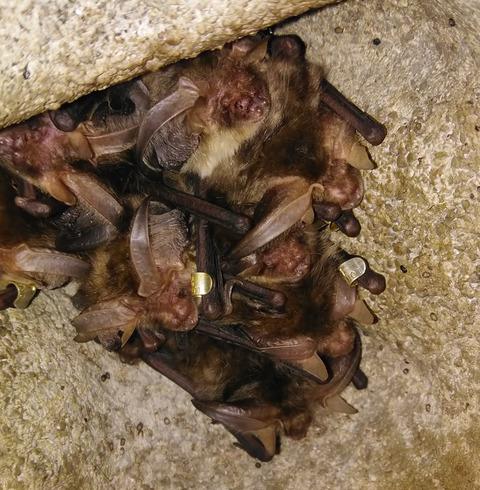Our official English website, www.x-mol.net, welcomes your
feedback! (Note: you will need to create a separate account there.)
The effect of group size, reproductive condition and time period on sexual segregation patterns in three vespertilionid bat species
Journal of Zoology ( IF 1.9 ) Pub Date : 2020-11-09 , DOI: 10.1111/jzo.12843 L. K. D. Katsis 1 , D. M. Linton 1 , D. W. Macdonald 1
Journal of Zoology ( IF 1.9 ) Pub Date : 2020-11-09 , DOI: 10.1111/jzo.12843 L. K. D. Katsis 1 , D. M. Linton 1 , D. W. Macdonald 1
Affiliation

|
Sexual segregation is widespread across the animal kingdom, yet there is limited consensus on the factors that shape this behavioural phenomenon. Many of the existing theories are based on study species with high levels of sexual size dimorphism. Insights from studies on species with minimal sexual size dimorphism, such as vespertilionid bats, provide an opportunity to study the factors associated with segregation irrespective of body size effects. Using long‐term data pooled from multiple bat box monitoring schemes across the U.K., we investigated segregation patterns in maternity roosts of three vespertilionid bat species, Bechstein’s bat, Myotis bechsteinii, Natterer’s bat, M. nattereri and brown long‐eared bat, Plecotus auritus. We used the Sexual Segregation and Aggregation Statistic (SSAS) to evaluate temporal trends of sexual segregation of roosts over the reproductive period (divided into pre‐parturition, lactation and post‐lactation periods). Additionally, we used generalized linear mixed models and beta regression models to investigate the effect of group size on segregation patterns. Our results showed that the size of the maternity group was an important covariate of inter‐ and intra‐sexual segregation, with males and non‐breeding females typically segregated from large maternity groups across all three periods. Additionally, we demonstrate that reproductive condition and period influence segregation patterns, with breeding females segregated from non‐breeding females and males during the lactation period. Although sexual segregation may be caused by multiple mechanisms, our results show that group size, female reproductive condition and time period are key factors associated with segregation within bat roosts. These findings make a valuable contribution to the understanding of inter‐ and intra‐sexual segregation in vespertilionid bats and complement existing research on segregation in other mammalian taxa, providing further evidence that sexual size dimorphism is not a prerequisite for sexual segregation.
中文翻译:

种群大小,生殖条件和时间段对3种蝙蝠科蝙蝠有性隔离模式的影响
在整个动物界中,性别隔离十分普遍,但对于影响这种行为现象的因素却缺乏共识。许多现有的理论都是基于具有高性大小二态性的研究物种。来自对具有最小性大小双态性的物种(例如,小孢子蝙蝠)的研究得出的见解为研究与隔离相关的因素提供了机会,而不论其体型大小如何。使用来自多个蝙蝠盒在英国监测方案汇集长期的数据,我们在三个vespertilionid蝙蝠生育栖息,贝希斯坦的蝙蝠,查处分离模式鼠耳蝠bechsteinii,纳氏鼠耳蝠,M. nattereri和普通长耳蝠,Plecotus auritus。我们使用了性别隔离和聚集统计(SSAS)来评估繁殖期(分为分娩前,哺乳期和哺乳期后)的栖息地性别隔离的时间趋势。此外,我们使用广义线性混合模型和β回归模型来研究群体规模对隔离模式的影响。我们的结果表明,产妇组的大小是性别间和性别内性别隔离的重要协变量,在这三个时期中,男性和非繁殖女性通常与较大的产妇组隔离。此外,我们证明了生殖条件和生育期会影响隔离模式,在哺乳期,育种雌性与非育种雌性和雄性分开。尽管性别隔离可能是由多种机制引起的,但我们的研究结果表明,群体规模,雌性生殖状况和时间段是与蝙蝠栖息地内隔离相关的关键因素。这些发现为了解维氏蝙蝠的性别内部和性别隔离做出了宝贵的贡献,并补充了其他哺乳动物类群中对性别隔离的现有研究,进一步证明了性别双态性不是性别隔离的先决条件。
更新日期:2020-11-09
中文翻译:

种群大小,生殖条件和时间段对3种蝙蝠科蝙蝠有性隔离模式的影响
在整个动物界中,性别隔离十分普遍,但对于影响这种行为现象的因素却缺乏共识。许多现有的理论都是基于具有高性大小二态性的研究物种。来自对具有最小性大小双态性的物种(例如,小孢子蝙蝠)的研究得出的见解为研究与隔离相关的因素提供了机会,而不论其体型大小如何。使用来自多个蝙蝠盒在英国监测方案汇集长期的数据,我们在三个vespertilionid蝙蝠生育栖息,贝希斯坦的蝙蝠,查处分离模式鼠耳蝠bechsteinii,纳氏鼠耳蝠,M. nattereri和普通长耳蝠,Plecotus auritus。我们使用了性别隔离和聚集统计(SSAS)来评估繁殖期(分为分娩前,哺乳期和哺乳期后)的栖息地性别隔离的时间趋势。此外,我们使用广义线性混合模型和β回归模型来研究群体规模对隔离模式的影响。我们的结果表明,产妇组的大小是性别间和性别内性别隔离的重要协变量,在这三个时期中,男性和非繁殖女性通常与较大的产妇组隔离。此外,我们证明了生殖条件和生育期会影响隔离模式,在哺乳期,育种雌性与非育种雌性和雄性分开。尽管性别隔离可能是由多种机制引起的,但我们的研究结果表明,群体规模,雌性生殖状况和时间段是与蝙蝠栖息地内隔离相关的关键因素。这些发现为了解维氏蝙蝠的性别内部和性别隔离做出了宝贵的贡献,并补充了其他哺乳动物类群中对性别隔离的现有研究,进一步证明了性别双态性不是性别隔离的先决条件。









































 京公网安备 11010802027423号
京公网安备 11010802027423号